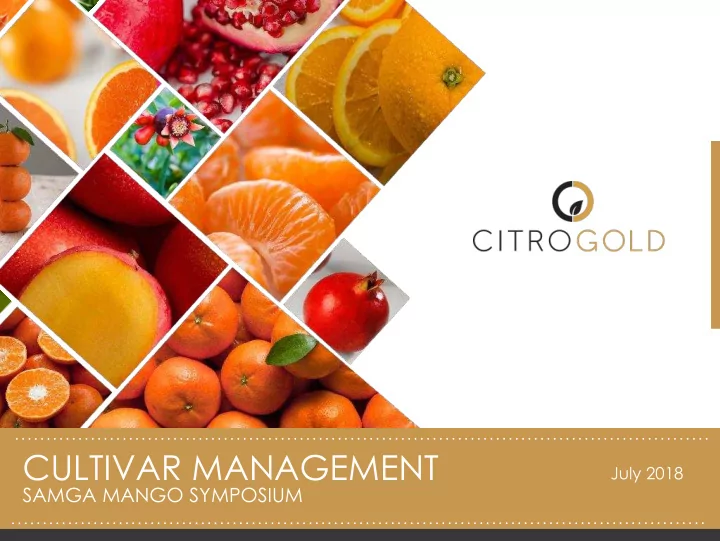

CULTIVAR MANAGEMENT July 2018 SAMGA MANGO SYMPOSIUM
CONTENTS Role of cultivar • management companies • Why new cultivars & cultivar development? • What are royalties and why you pay these? • How should growers decide on new cultivars
CULTIVAR MANAGEMENT COMPANIES • Manage new cultivars on behalf of the Owner • Develop, test and evaluate cultivar • Apply for registration of PBR or Patent (USA) • Enforce PBR • Develop and implement business plans, locally and worldwide • Business models for each cultivar are developed in conjunction with owner • Match supply (plantings) with demand (fruit) • Collection and payment of royalties to Breeders • Build value for the variety for Growers through co-ordinated marketing to do market development
WHY CULTIVAR MANAGEMENT COMPANIES? Breeders don’t have the time or expertise to commercialise new cultivars. Protection and commercialisation of new cultivars requires: • Applied technical evaluation • Specialised legal knowledge of PBR and patent law • Proficient administration systems • Good business skills • Global representation and networks
PBR The effect of the grant of a PBR is that any person wanting to undertake: • Production or reproduction; • Conditioning for the purpose of propagation; • Sale or any other form of marketing; • Stocking for any of the purposes referred to above, of (1) propagation material; (2) harvest material, may only do so with permission from the PBR holder, i.e. through a granted license.
WHY NEW CULTIVARS? • Growers and Markets seek new cultivars • Enhances competitiveness of Growers and Marketers • Retailers want to differentiate • A new cultivar is an improvement of current cultivars • Yields • Fruit size and colour • Maturity period • Lower seed content • Better internal quality, etc.
CULTIVAR DEVELOPMENT Conventional breeding: • Open pollinated crosses • Hand crosses • Mutation breeding • Hybrids and triploids • High costs incurred by breeder and cultivar management companies Natural mutations: • Occur naturally without ‘human intervention’ • Most commonly discovered on- farm • Still require years of development and evaluation by cultivar management companies • Relatively low costs
WHY ROYALTIES? 1. Recover the costs incurred by Breeders in developing new cultivars 2. Incentive for Breeders to develop new cultivars 3. Incentive for Growers to look for new cultivars/mutations 4. Access to the latest cultivars from around the world for Growers Plant Breeders (PBR) Act of South Africa allows: • Promotion of innovation and value • Breeders and Developers of new cultivars to have ownership of their new cultivars; and • To charge royalties on these cultivars
ROYALTIES? What are Royalties? Payment for the right to grow (and sell the fruit of) a protected cultivar. Types of Royalties • Tree Royalty (Rand/Tree – once-off) • Hectare / Production Royalty (Rand/Ha/Year) • Fruit Royalty ( % of FOB) Duration of Royalties Applied during the period of PBR grant of 25 years.
WHY ROYALTIES? 1. Recover the costs incurred by Breeders in developing new cultivars 2. Incentive for Breeders to develop new cultivars 3. Incentive for Growers to look for new cultivars/mutations 4. Access to the latest cultivars from around the world for Growers Plant Breeders (PBR) Act of South Africa allows: • Promotion of innovation and value • Breeders and Developers of new cultivars to have ownership of their new cultivars; and • To charge royalties on these cultivars
MAKING CULTIVAR DECISIONS • Know yourself. • Understand the cultivars’ category and development stage. • Do your own research. • Count the Costs and Know the Risks.
KNOW YOURSELF
UNDERSTAND THE CULTIVAR STAGE • Experimental • Potential • Semi-Commercial • Commercial
DO YOUR RESEARCH • Interrogate the cultivars owner/manager • Visit trial sites and commercial plantings (local and abroad) for 2 consecutive seasons.
COUNT THE COSTS AND KNOW THE RISK Higher risk, higher possible reward OR possible cost of failure. The final risk is yours.
THANK YOU SOUTH AFRICA | USA | EUROPE - MEDITERRANEAN | CHILE - PERU | AUSTRALIA | CHINA
Recommend
More recommend